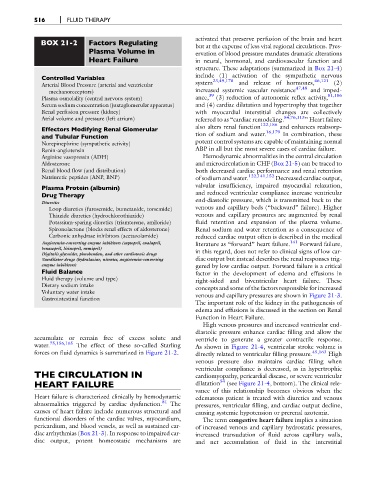Page 528 - Fluid, Electrolyte, and Acid-Base Disorders in Small Animal Practice
P. 528
516 FLUID THERAPY
BOX 21-2 Factors Regulating activated that preserve perfusion of the brain and heart
but at the expense of less vital regional circulations. Pres-
Plasma Volume in ervation of blood pressure mandates dramatic alterations
Heart Failure in neural, hormonal, and cardiovascular function and
structure. These adaptations (summarized in Box 21-4)
Controlled Variables include (1) activation of the sympathetic nervous
23,49,178
46,121
Arterial Blood Pressure (arterial and ventricular system and release of hormones, (2)
47,48
mechanoreceptors) increased systemic vascular resistance and imped-
Plasma osmolality (central nervous system) ance, 39 (3) reduction of autonomic reflex activity, 81,186
Serum sodium concentration (juxtaglomerular apparatus) and (4) cardiac dilatation and hypertrophy that together
Renal perfusion pressure (kidney) with myocardial interstitial changes are collectively
Atrial volume and pressure (left atrium) referred to as “cardiac remodeling. 54,76,113 ” Heart failure
Effectors Modifying Renal Glomerular also alters renal function 122,186 and enhances reabsorp-
16,179
and Tubular Function tion of sodium and water. In combination, these
potent control systems are capable of maintaining normal
Norepinephrine (sympathetic activity)
Renin-angiotensin ABP in all but the most severe cases of cardiac failure.
Arginine vasopressin (ADH) Hemodynamic abnormalities in the central circulation
Aldosterone and microcirculation in CHF (Box 21-5) can be traced to
Renal blood flow (and distribution) both decreased cardiac performance and renal retention
Natriuretic peptides (ANP, BNP) of sodium and water. 122,141,152 Decreased cardiac output,
Plasma Protein (albumin) valvular insufficiency, impaired myocardial relaxation,
Drug Therapy and reduced ventricular compliance increase ventricular
end-diastolic pressure, which is transmitted back to the
Diuretics
Loop diuretics (furosemide, bumetanide, torsemide) venous and capillary beds (“backward” failure). Higher
Thiazide diuretics (hydrochlorothiazide) venous and capillary pressures are augmented by renal
Potassium-sparing diuretics (triamterene, amiloride) fluid retention and expansion of the plasma volume.
Spironolactone (blocks renal effects of aldosterone) Renal sodium and water retention as a consequence of
Carbonic anhydrase inhibitors (acetazolamide) reduced cardiac output often is described in the medical
Angiotensin-converting enzyme inhibitors (captopril, enalapril, literature as “forward” heart failure. 141 Forward failure,
benazepril, lisinopril, ramipril)
Digitalis glycosides, pimobendan, and other cardiotonic drugs in this regard, does not refer to clinical signs of low car-
Vasodilator drugs (hydralazine, nitrates, angiotensin-converting diac output but instead describes the renal responses trig-
enzyme inhibitors) gered by low cardiac output. Forward failure is a critical
Fluid Balance factor in the development of edema and effusions in
Fluid therapy (volume and type)
right-sided and biventricular heart failure. These
Dietary sodium intake
concepts and some of the factors responsible for increased
Voluntary water intake
venous and capillary pressures are shown in Figure 21-3.
Gastrointestinal function
The important role of the kidney in the pathogenesis of
edema and effusions is discussed in the section on Renal
Function in Heart Failure.
High venous pressures and increased ventricular end-
diastolic pressure enhance cardiac filling and allow the
accumulate or remain free of excess solute and ventricle to generate a greater contractile response.
water. 75,156,165 The effect of these so-called Starling As shown in Figure 21-4, ventricular stroke volume is
forces on fluid dynamics is summarized in Figure 21-2. directly related to ventricular filling pressure. 45,163 High
venous pressure also maintains cardiac filling when
ventricular compliance is decreased, as in hypertrophic
THE CIRCULATION IN cardiomyopathy, pericardial disease, or severe ventricular
HEART FAILURE dilatation 54 (see Figure 21-4, bottom). The clinical rele-
vance of this relationship becomes obvious when the
Heart failure is characterized clinically by hemodynamic edematous patient is treated with diuretics and venous
abnormalities triggered by cardiac dysfunction. 81 The pressures, ventricular filling, and cardiac output decline,
causes of heart failure include numerous structural and causing systemic hypotension or prerenal azotemia.
functional disorders of the cardiac valves, myocardium, The term congestive heart failure implies a situation
pericardium, and blood vessels, as well as sustained car- of increased venous and capillary hydrostatic pressures,
diac arrhythmias (Box 21-3). In response to impaired car- increased transudation of fluid across capillary walls,
diac output, potent homeostatic mechanisms are and net accumulation of fluid in the interstitial

